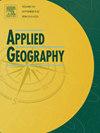Social vulnerability gaps: Dynamics of the unsheltered homeless and wildfire hazards
IF 5.4
2区 地球科学
Q1 GEOGRAPHY
引用次数: 0
Abstract
Demographic and socio-economic omissions in social vulnerability assessments are not uncommon. However, conclusions from incomplete population characterization contribute to inequity and marginalization of at-risk segments of society, individuals who require care, resource assistance, and tailored public policy. The unsheltered homeless are considered here as an underrepresented segment of socially vulnerable people in hazard assessment. The unsheltered suffer disproportionately higher levels of direct exposure to natural and human-caused disasters, yet their lack of stable housing and often frequent moves make them both hidden and invisible in traditional census information. An exploratory spatial data analysis framework is developed to combine geographic information systems (GIS), statistics, and geostatistics to assess the implication of this omission. This research treats the integration of annual government counts and continuously updated, community-contributed information as a means of capturing regional spatial patterns of unsheltered homelessness at a fine geographic level. Comparison is then made to approaches based on traditional social vulnerability measures to evaluate consistency and representativeness. The findings suggest a significant gap in existing approaches. This study sheds light on potential avenues for more inclusive and accurate assessments of social vulnerability in the context of hazards.
社会脆弱性差距:无家可归者和野火灾害的动态
社会脆弱性评估中人口和社会经济方面的遗漏并不罕见。然而,从不完整的人口特征得出的结论会导致社会风险群体、需要照顾、资源援助和量身定制的公共政策的个人的不平等和边缘化。在这里,无家可归者被认为是危险评估中社会弱势群体中代表性不足的一部分。没有住所的人直接遭受自然灾害和人为灾害的程度更高,但他们缺乏稳定的住房,经常搬家,这使他们在传统的人口普查信息中既隐蔽又不可见。开发了一个探索性空间数据分析框架,将地理信息系统(GIS)、统计学和地质统计学相结合,以评估这种遗漏的含义。本研究将年度政府统计和不断更新的社区提供的信息作为一种手段,在精细的地理水平上捕捉无家可归者的区域空间格局。然后与基于传统社会脆弱性度量的方法进行比较,以评估一致性和代表性。研究结果表明,现有方法存在重大差距。这项研究揭示了在灾害背景下对社会脆弱性进行更具包容性和准确性评估的潜在途径。
本文章由计算机程序翻译,如有差异,请以英文原文为准。
求助全文
约1分钟内获得全文
求助全文
来源期刊

Applied Geography
GEOGRAPHY-
CiteScore
8.00
自引率
2.00%
发文量
134
期刊介绍:
Applied Geography is a journal devoted to the publication of research which utilizes geographic approaches (human, physical, nature-society and GIScience) to resolve human problems that have a spatial dimension. These problems may be related to the assessment, management and allocation of the world physical and/or human resources. The underlying rationale of the journal is that only through a clear understanding of the relevant societal, physical, and coupled natural-humans systems can we resolve such problems. Papers are invited on any theme involving the application of geographical theory and methodology in the resolution of human problems.
 求助内容:
求助内容: 应助结果提醒方式:
应助结果提醒方式:


